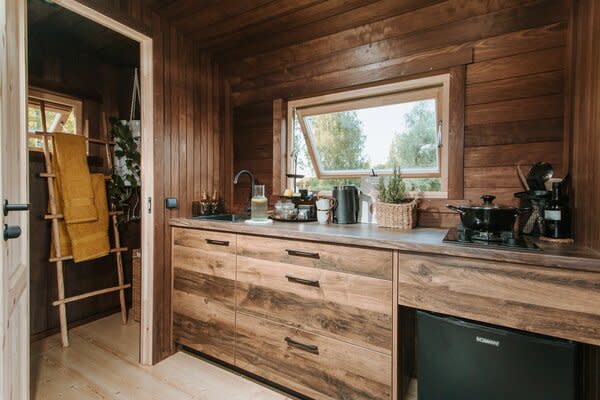Forget the Conversation Pit. These Tiny Homes Have a Conversation Platform
Vagabond Haven’s Elise model has a raised living area with a woodburning stove and space for a second bedroom below.

Welcome to Tiny Home Profiles, an interview series with people pushing the limits of living small. From space-saving hacks to flexible floor plans, here’s what they say makes for the best tiny homes on the planet. Know of a builder we should talk to? Reach out.
Wherever Manuel Kohout went on his travels, he couldn’t help but see tiny homes. The small structures were rarely called that, but whether they were thatch-roofed cottages, house boats, Mongolian yurts, or log houses, they all shared a distinct pragmatism, craftsmanship, and adaptability. When Manuel returned to Sweden in 2016, he was struck by the absence of any type of tiny home there. "I wanted to change that," he tells us. "So, I started my company, Vagabond Haven, and built the first tiny house as a prototype." Manuel moved into the model with his two daughters as a way to evaluate his design first-hand—and would continue to do so for many of Vagabond Haven’s subsequent models. Here, we asked Manuel about what he and his customers like most about his tiny houses.
What qualities make your tiny home stand apart from the rest?
The most important thing to us is to build beautiful and practical houses that can contribute to a more sustainable and freer lifestyle. The materials used are naturally a very important aspect, and we strive to use environmentally friendly building materials as much as possible: from the insulation made of sheep’s wool or recycled textiles, down to the environmentally friendly paints we use. Another important aspect is mobility: all our houses weigh under three-and-a-half tons and can thus be transported behind a car. To achieve this, we use lightweight materials, such as poplar (for the furniture) or aluminum (for the roof). Many of our customers want to live off-grid. Therefore, we also offer a whole range of off-grid solutions, from solar panels, to a rainwater harvesting system, various dry toilets, and wood, pellet, or gas stoves.
See the full story on Dwell.com: Forget the Conversation Pit. These Tiny Homes Have a Conversation Platform
Related stories:



